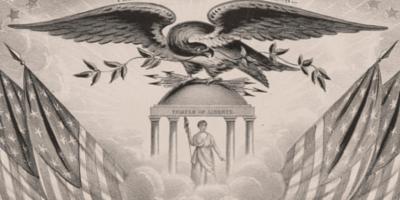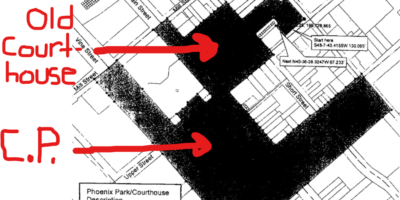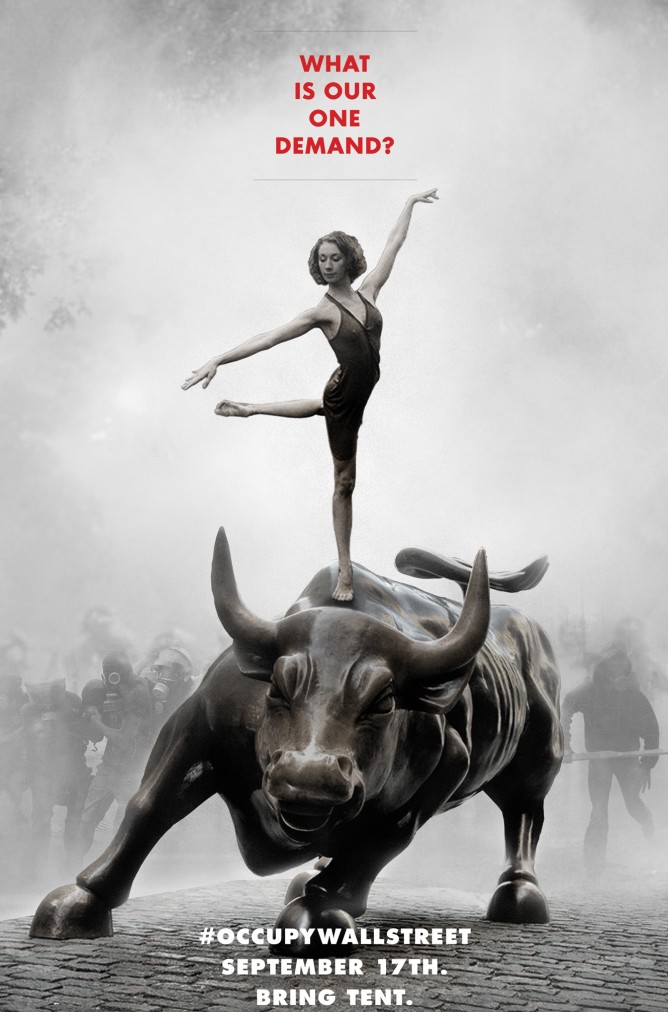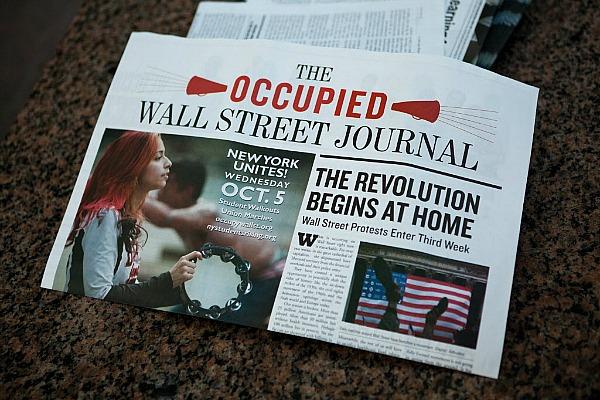Something’s happening here
By Michael Benton
The question that must be asked is whether we are witnessing the birth of a new social movement in America. As I am writing this article Occupy Wall Street is starting Day 25 and it is spreading on a national and global scale. There are now Occupations and Meetups in 1359 cities operating in solidarity with the protesters in New York City. (You can find lists of current Occupations across the globe at http://www.meetup.com/occupytogether.) Occupy Lexington was the third city to organize an Occupation when a few protesters gathered on September 29 at noon in front of the Downtown JP Morgan Chase Bank plaza.
I first heard about the plans for the occupation of Wall Street from Adbusters’ editor and writer Micah White in July of 2011. Soon afterward, I saw the ads of a ballerina doing a pirouette on top of the iconic Wall Street bull statue appearing in the magazine’s September 2011 “Post-Anarchism” issue and in various announcements from activist groups.
Slowly people started discussing the possibilities of the occupation through emails, in person, and on forums.
Global roots: Looking east, south and west
Where, then, did the inspiration for the Occupy Wall St. and the solidarity protests arise from? Perhaps the most electrifying moment was the Arab Spring of 2011 which seemed to happen spontaneously across the Middle East and North Africa, with predominantly young people taking the forefront of these movements to challenge authoritarian dictatorships. Their embrace of social media, which had been viewed with suspicion by many cultural critics in the West, demonstrates that effective social movement organizing is possible through social media technologies. The revolutions in Tunisia and Egypt, as well as the courageous challenges of young protesters in the face of draconian measures in all of the regional protests, inspired people around the world.
Another primary inspiration was the Spanish acampadas (camping, or temporary encampment) that began out of disgust for electoral politics as usual in Spain and continued to spread and grow as the politics of occupying urban spaces interweaved with networking through social media. Beginning with several hundred people on May 15, the Spanish occupations increased into the thousands by the time of the May 25 elections and continues still today. These acampadas provided a model for the Occupy Wall Street protests with their emphasis on occupying urban spaces through festive gatherings. Their emphasis on peaceful protesting, consensus decision-making, leaderless movements (or better yet an emphasis on autonomy, whereby all have the capabilities/responsibility to lead) and a push for Democracia Real Ya can be seen in the current Occupy protests.
Although not as often cited as direct influences, but no doubt significant, were the various Latin American campesino land movements and the dramatic, successful, 2000 Cochabamba resistance of citizens against foreign companies attempting to privatize and control all water resources in Bolivia.
What must be recognized here is that American social justice movements had lost their focus and been weakened by state repression. The various movements centered upon environmentalist, anti-war and social/economic justice issues had faced state repression in the aftermath of 9/11, when the American Homeland security forces began identifying domestic activists as terrorist threats. Furthermore, the wide variety of important social justice issues tended to divide the force of these groups into a cycle of fractured attempts to create meaning through repetitive Washington, D.C. marches.
The rest of the world in their continuing fight for justice have provided us maps for once again speaking truth to power and claiming our responsibilities as citizens in a democracy. The world has been waiting for us to wake-up and this may be our American Autumn.
Birth of a movement: Americans join the world
When the Occupy Wall Street occupation began on September 17, it was predominantly young people that gathered in the heart of America’s financial district. This made it easy for many to dismiss participants as hippies and naïve young college students. Surprisingly I found some of the most committed activists rejecting them because they did not have a set “program” as if they should be Athena springing fully formed from Zeus’ skull. (Other, more cautious, activists declared that they needed time to develop their voices and that if people were concerned they needed to join with them in occupying Wall Street or a location near them.)
The young activists’ determination in the face of increasing police brutality stunned many older progressives out of their lethargy and softened many more conservative people to their message. Despite the corporate media’s near blackout on the issue the first week, word about the occupation was being spread through email, websites, Youtube videos and social media.
It was during the second week that we saw the possibility for people to use social media technologies to amplify their voices and concerns when the corporate media wouldn’t give them a voice. In a few days of concentrated police brutality, America and the world saw videos of the highest ranking police officers (white shirts signifying the rank of Lieutenant or higher) pepper spraying peaceful young women in the face, smacking heads of young men against vehicles, and mass arrests of peaceful protesters.
The message being communicated was very clear: the word had come down from the upper echelons to the ranking police officers: this must end now. The resounding response to these brutalities was more protesters joining the Occupy Wall Street and the beginnings of solidarity protests in other cities. By the time of the mass arrests of 700 protesters on the Brooklyn Bridge on October 2, the slumbering, powerful New York unions decided that they would join with the protesters and many influential people began to join with the Wall St occupation providing statements of support.
The third week started with a video of Wall St executives coming out on their balcony to mockingly toast with champagne glasses the marching protesters. It was a scene that etched in the minds of viewers the extreme hubris of the finance sector. They were literally fiddling like Nero before the fires that were plaguing their empire. At the same time thousands of print copies of a new publication, Occupied Wall Street Journal, began to be distributed in New York. Readily available to anyone in the world as a PDF file online, on October 9 the second issue was released, while the first issue was featured in publications from The Nation to the Business Insider.
In the meantime, we have seen the beginnings of a national and now global movement of Solidarity Occupations and Meetups to join and discuss this movement. The world has been wondering how long American citizens would remain quiet about the excesses of their corporate financed oligarchy. The question has at least been raised, and now we must answer whether this is truly our American Autumn.






Michael Benton
Charles Warren no doubt had an axe to grind and we can see clearly where he is wrong and where he is grossly mistaken.
1) We currently are dominated by the party whose stated mission is to end ‘big government’ headed by a “leader” that campaigned on a promise to “drain the swamp” in DC. In reality these false flag neo-conservatives seek/pursue large scale government handouts and largesse, while cutting all aid to the most vulnerable. For instance, the obscene, bloated, military budget is going to be raised 700 billion dollars (again). The absurd and ineffective plan to build a wall at the Southern border is not even a part of that budget and is being funded by raids on actual necessary social services like FEMA.
2) Occupy was multicultural in its makeup overall and the notion that they were a bunch of hippies (not that there is anything wrong with that) is laughable. It was a truly impressive example of people coming together around the world in organized resistance. The movement is still going strong and the ideas/people have been spreading through other social movements. They also have been very active in the debt forgiveness movement and the Occupy ICE movement. A quick browse of The Guardian’s archive page on the movement (which is still active) demonstrates how mistaken (intentional or not) Charles Warren is about the effectiveness and longevity of the Occupy Movement https://www.theguardian.com/world/occupy
Charles Warren
Bad ideas have a way of fizzling out and just going away. Like communism and psychoanalysis, the Occupy Movement was but one more glaring example of how wrong, wrong can be, and, to be sure, the occupiers had it completely backwards. They were 180 degrees wrong.
They should have been protesting big government rather than business and industry, because it was the Government Sponsored Enterprises, Fannie Mae and Freddy Mac, that burst the housing bubble, caused some 150 large banks to fail, and ultimately gave us in the 2008 economic “crisis.” If anything, Wall Street was a victim of the GSE’s unfettered abuse. And while it could be said that Wall Street was a victim of its own greed—that’s really the only cogent argument against private corporations—we must come to terms with the idea that out of control government was the root cause. But the occupiers didn’t understand this. Instead, they took to the streets and banged their cynical, superficial drum as loudly as they possibly could.
What was more, and even at the height of the Occupy Movement’s influence on American thought, the occupiers themselves refused to approach the situation with any genuine sense of clarity or rationale. This was due in part to the complex nature of the GSE’s relationship with the private sector; moreover, it was largely due to the occupiers’ vain reluctance to believe that government was at fault for causing so much economic turmoil. To their way of thinking, Wall Street was solely to blame. And they’d not hear another word about it. After all, Obama had just been elected President of the United States of America. It was a new day. The times were a-changing. We were becoming a more socialist nation, perhaps after the fashion of a European model, England, or Ireland, or Germany. The occupiers wanted us to become more socialistic in thought and practice.
At the end of the day, though, we find the occupiers to be silly self-invested rebels who thought they had a cause.
Charles Warren
Thankfully, the Occupy Wall Street Movement is dead. Google it, and you’ll find everyone asking “is OWS dead?” The thing is, if you gotta ask….
What went wrong with OWS was that it was made up of a lot of white, privileged hippie types who weren’t rebels, but who imagined that they had a cause. It doesn’t get any stupider than that.
Did it ever occur to them to “occupy” government?